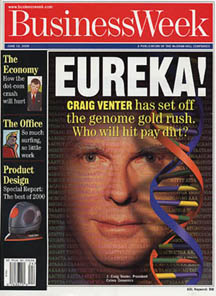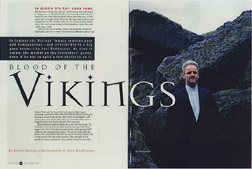
ISIS Recoding Life Project
IAS Fellowship
deCODE Comments
Open Reading Frames
ISIS Publications
Links
Contact us
Search
Projects Overview
MilWaste Program
Amazon Project
Quantum Physics
Seminars
Science Dialogue
Recoding Life
ISIS Fellows
Open Reading Frames: The Genome and the Media - Mike Fortun - Page 4
 Let's return briefly to Venter, here on the cover of Business Week with an ancient greek expression hovering in the space over his head. I'm interested in the identification of the genomics company with its CEO that happens often in the media. Part of this personalization effect is that a face of a guy looks better on the cover of your magazine than some high-tech stripmall building in Rockville. But there was certainly some "taking it personally" between Venter and Francis Collins. The sentiment on the public side of things seemed to be more "that asshole did it to us" rather than "the genomics political economy that we helped establish years ago by funding the HGP infrastructure to keep America competitive has now come back in the form of Celera/PE Systems to bite us in the ass..." Just as non-linear and epigenetic effects so often get collapsed and reduced into "gene x causes trait y," a very complex political economy of bioinformation and biomaterials is collapsed into "Craig Venter." And let me stress again: it's not so much a question of right and wrong readings here. Craig Venter is Celera Genomics within some limited reading frames, as surely as gene x causes trait y within some limited reading frames. But that doesn't preclude other ways of reading that can be just as truthful and necessary. Perhaps it's best to say: Celera Genomics, like all good nonlinear systems, both is and isn't Craig Venter, and it's always the irresolvable tension of the AND that is so productive - in organisms, in the life sciences, and in economies. And in history. Now I'd like to shift territories to a different identification between a genomics company and its CEO, but I want to get there via a marginal route. As Preston tells the story, sometime in the early spring of 2000, Celera began assembling the human DNA sequences it had been churning out from multiple shotgunned fragments - "a pretty boring" job, according to Venter. Which may explain why the moment had to be amped up with a little ritual:
It's too bad one can't own stock in RichardWagner.com, since the dramatic musical purveyance of old Norse myths of supernatural women swooping down over battlefields to gather dead Viking heroes and resurrect them to a new life in Valhalla clearly presents an opportunity for ongoing future returns.  As the case of the U.S. corporation deCODE Genetics, operating in Iceland, makes clear. A series of old and contemporary Viking myths have been invoked by deCODE and its volatile CEO and founder Kari Stefansson. [asshole] These myths, particularly the parts depicting the supposed isolation and homogeneity of Iceland and its population, have been reiterated consistently in both the Icleandic and international media, and have been vital to deCODE's efforts to leverage itself into the competitive global genomics economy. A very brief and simplified encapsulation for those few of you who may not be familiar with the deCODE Genetics saga. Often called an Icelandic company, deCODE is a U.S. corporation founded in 1996 by Stefansson while he was at Beth Israel Deaconness Medical Center, with $12 million from U.S. venture capital firms associated with Harvard and the University of Chicago. With virtually no record of gene discovery research, let alone high-throughput genomics work of any kind, Stefansson leveraged deCODE to international attention when he secured a 5-year promise of $200 million in research and milestone payments from the Swiss company Hoffmann-La Roche in February 1998. |